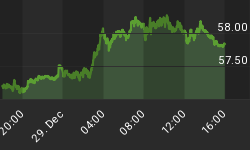Here is an extract from commentary posted at www.speculative-investor.com on 14th August 2003:
The Fed left interest rates unchanged at Tuesdays monetary policy meeting, something that shouldn't have surprised anyone. What was of interest, though, was the way the Fed's monetary policy announcement was worded. In particular, the Fed reiterated its view that the main concern for the foreseeable future was for "undesirably low" inflation and confirmed that short-term interest rates could stay low for a "considerable period".
Now, Greenspan and Co. can say whatever they want about interest rates but at the end of the day the market will determine when short-term rates are hiked and by how much. For example, there's a reasonable chance that bond prices will work their way higher over the next 2-3 months, thus giving the Fed some breathing room. However, this bond rally will most likely turn out to be a counter-trend move that will be followed by a drop to well below the recent lows. When long-term interest rates push above 5%, then 6%, and then start heading rapidly towards 7%, is the Fed really going to be able to or willing to hold the Fed Funds Rate at 1%? If they did then inflation expectations would spiral out of control, the US$ would collapse and we'd have a 4-digit gold price on our hands. The bottom line is; regardless of what policy-makers are telling us now, the Fed will only be able to hold the Fed Funds Rate at the current low level beyond the next few months in the extremely unlikely event that the US really does start to experience deflation.
The Fed's stated intention to leave short-term interest rates at an artificially low level for as long as deemed necessary is, however, important because it confirms that the Fed has no desire to be pre-emptive with regard to the building inflation problem. In effect, the Fed has confirmed that it will keep short-term rates at a low level until the market forces it to do otherwise, that is, until the inflation problem becomes obvious to all. This, in turn, means that the natural hedges against a loss of confidence in the US$ are going to have a lot more room to run than would be the case if the Fed was primarily concerned about suppressing the effects of inflation. This is why we headed this section with "The Fed gives gold investors a green light".
In addition to giving gold investors a green light the Fed has just given bond investors a kick in the stomach. This obviously wouldn't have been their intention because long-term interest rates must remain low if the great US credit expansion is to continue, but it would appear that the bond market is beginning to sense the inflation problem that has been brewing now for years. So when the Fed now says it is concerned about undesirably low inflation, thus implying that a goal of current Fed policy is currency depreciation, bond investors head for the hills.
But why the sudden fear on the part of bond investors? After all, didn't everything in bond land seem rosy just 2 months ago?
As we've argued in the past, we think the huge run-up in bond prices (plunge in long-term interest rates) over the first 6 months of this year was, to a large extent, a consequence of the falling US$. Specifically, the falling dollar prompted foreign central banks (mainly the Japanese) to aggressively buy dollars in the currency market and these dollars were, in turn, invested in US Treasury and Agency debt. When the dollar stopped falling a large slice of this central bank buying support was removed and US bonds were left to trade based on their own fundamentals. Therefore, a resumption of the dollar's downward trend will probably coincide with the start of a sizeable rally in the bond market.
The Fed is continually trying to manage inflation expectations in order to get the markets to behave in a particular way. The problem is; the gap between what the Fed wants the markets to do and what the markets should be doing based on the reality of the situation is becoming unmanageable.
















